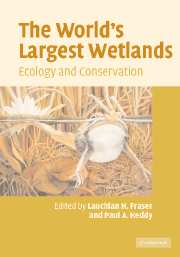Book contents
- Frontmatter
- Contents
- List of contributors
- Preface
- 1 Introduction: big is beautiful
- 2 The West Siberian Lowland
- 3 The Amazon River basin
- 4 The Hudson Bay Lowland
- 5 The Congo River basin
- 6 The Mackenzie River basin
- 7 The Pantanal
- 8 The Mississippi River alluvial plain
- 9 The Lake Chad basin
- 10 The River Nile basin
- 11 The prairie potholes of North America
- 12 The Magellanic moorland
- 13 The future of large wetlands: a global perspective
- Index
- References
10 - The River Nile basin
Published online by Cambridge University Press: 10 August 2009
- Frontmatter
- Contents
- List of contributors
- Preface
- 1 Introduction: big is beautiful
- 2 The West Siberian Lowland
- 3 The Amazon River basin
- 4 The Hudson Bay Lowland
- 5 The Congo River basin
- 6 The Mackenzie River basin
- 7 The Pantanal
- 8 The Mississippi River alluvial plain
- 9 The Lake Chad basin
- 10 The River Nile basin
- 11 The prairie potholes of North America
- 12 The Magellanic moorland
- 13 The future of large wetlands: a global perspective
- Index
- References
Summary
Introduction
The River Nile is one of the largest rivers in Africa and is the longest river in the world, flowing 6825 km from southeast Africa to the north of Africa – its latitude extending from 4°S to 31°N (Fig. 10.1). Its basin embraces many climates from extreme arid – with annual rainfall of less than 1 mm in the Nubian part of Egypt and Sudan – to 1500 mm on the Ethiopian plateau, and as much as 1800 mm in the mountains of Rwanda and Burundi. Two primary factors govern the present extent of the vegetation along the Nile, namely the climate and the hydrographic network. However, the aquatic and riparian vegetation of the Nile basin is not greatly affected by local climatic changes, the swamp conditions existing whenever the land is either permanently under water or subjected to seasonal flooding.
Although the downstream part of the Nile crosses an extremely arid region without any significant water gains, Täckholm (1976) describes the Egyptian landscape of the Nile valley in the ancient past: “during the Neolithic and also the Pharaonic times [it] had the character of the Sudd region of the present Sudan, a river with marshy shores where huge papyrus thickets offered a splendid abode for hippopotami and crocodiles, for birds and other animals.” Her description was based on plant remains found in Pharaonic tombs, ancient drawings, and records written on papyrus.
- Type
- Chapter
- Information
- The World's Largest WetlandsEcology and Conservation, pp. 347 - 392Publisher: Cambridge University PressPrint publication year: 2005



